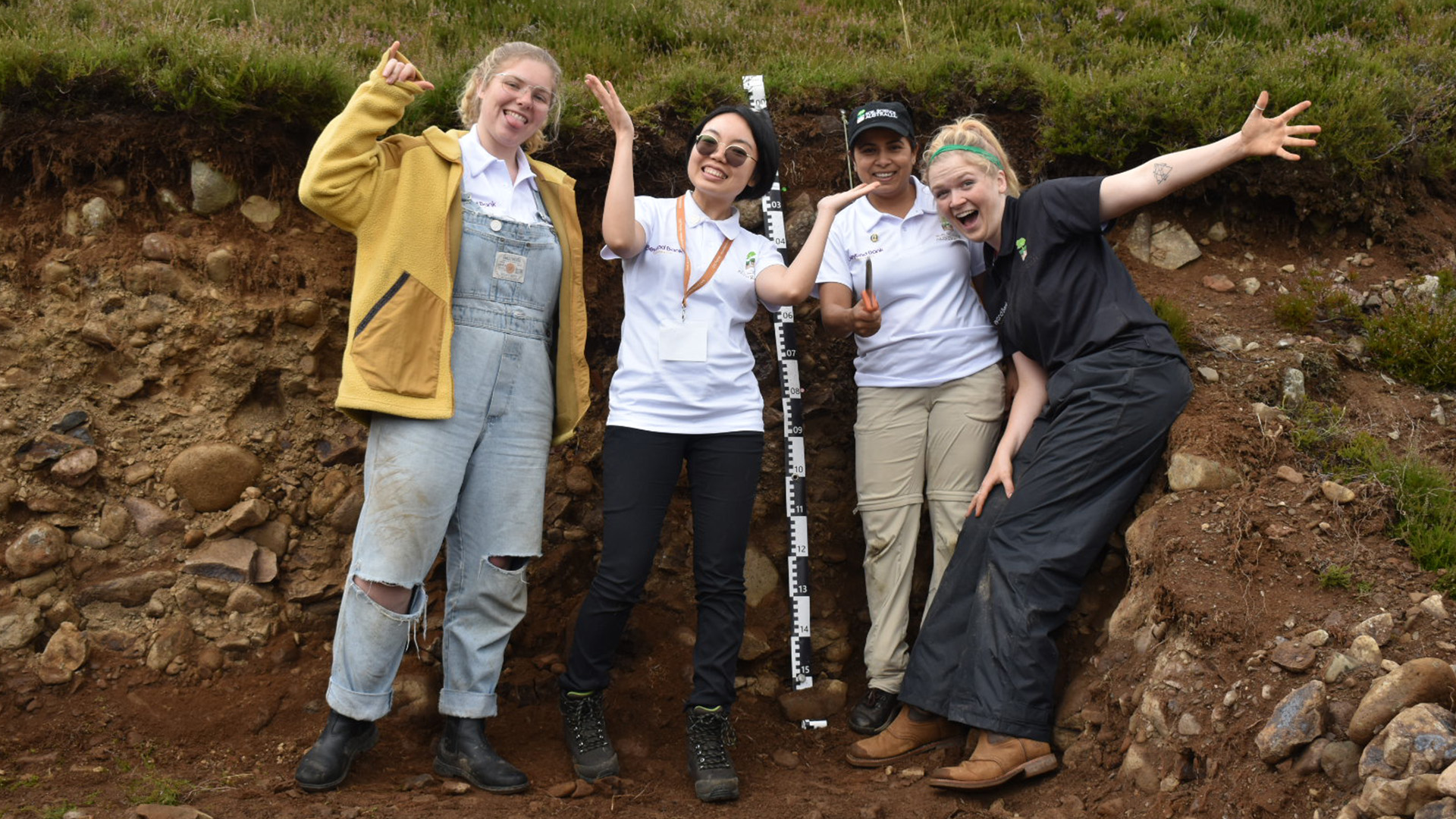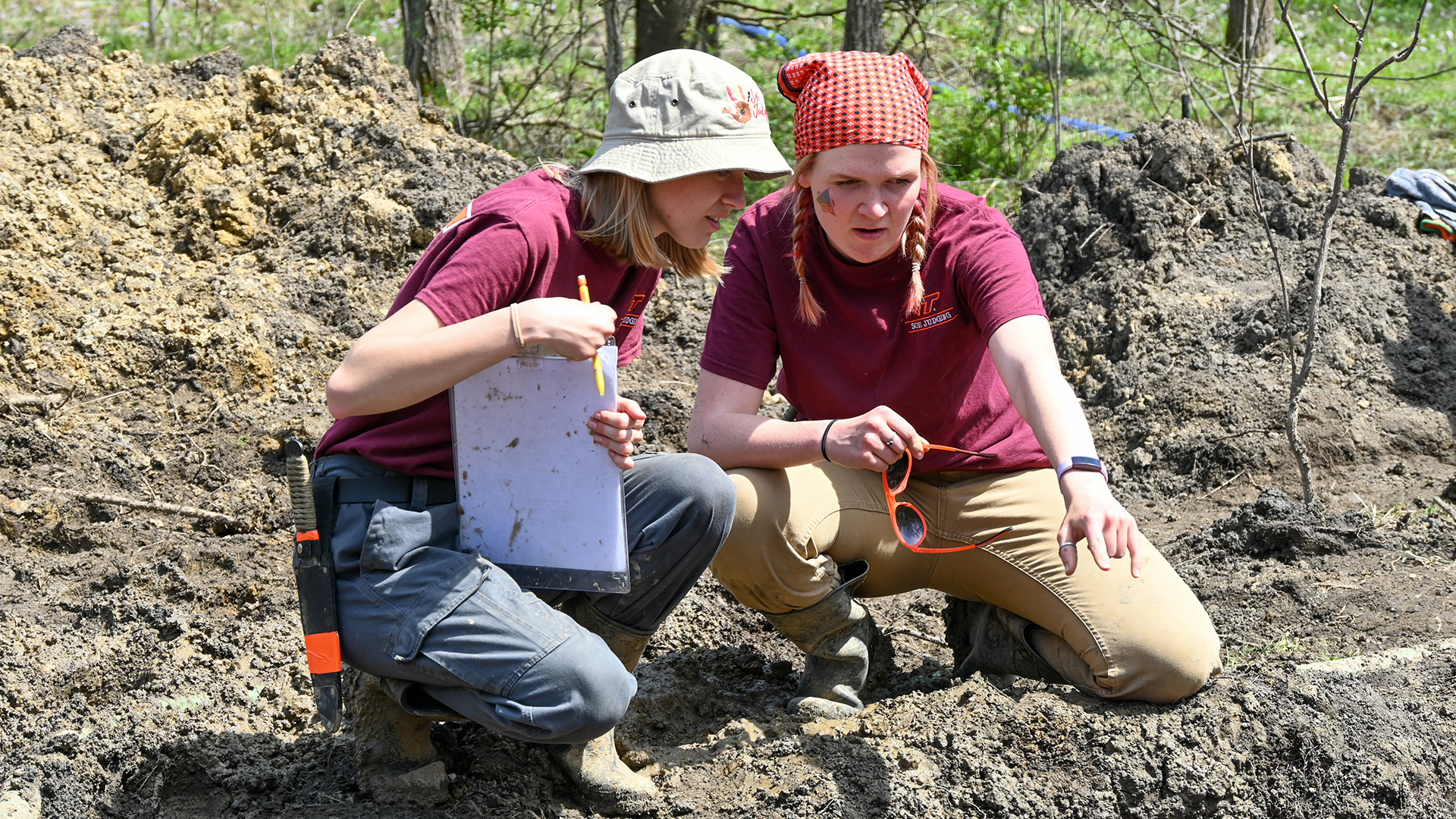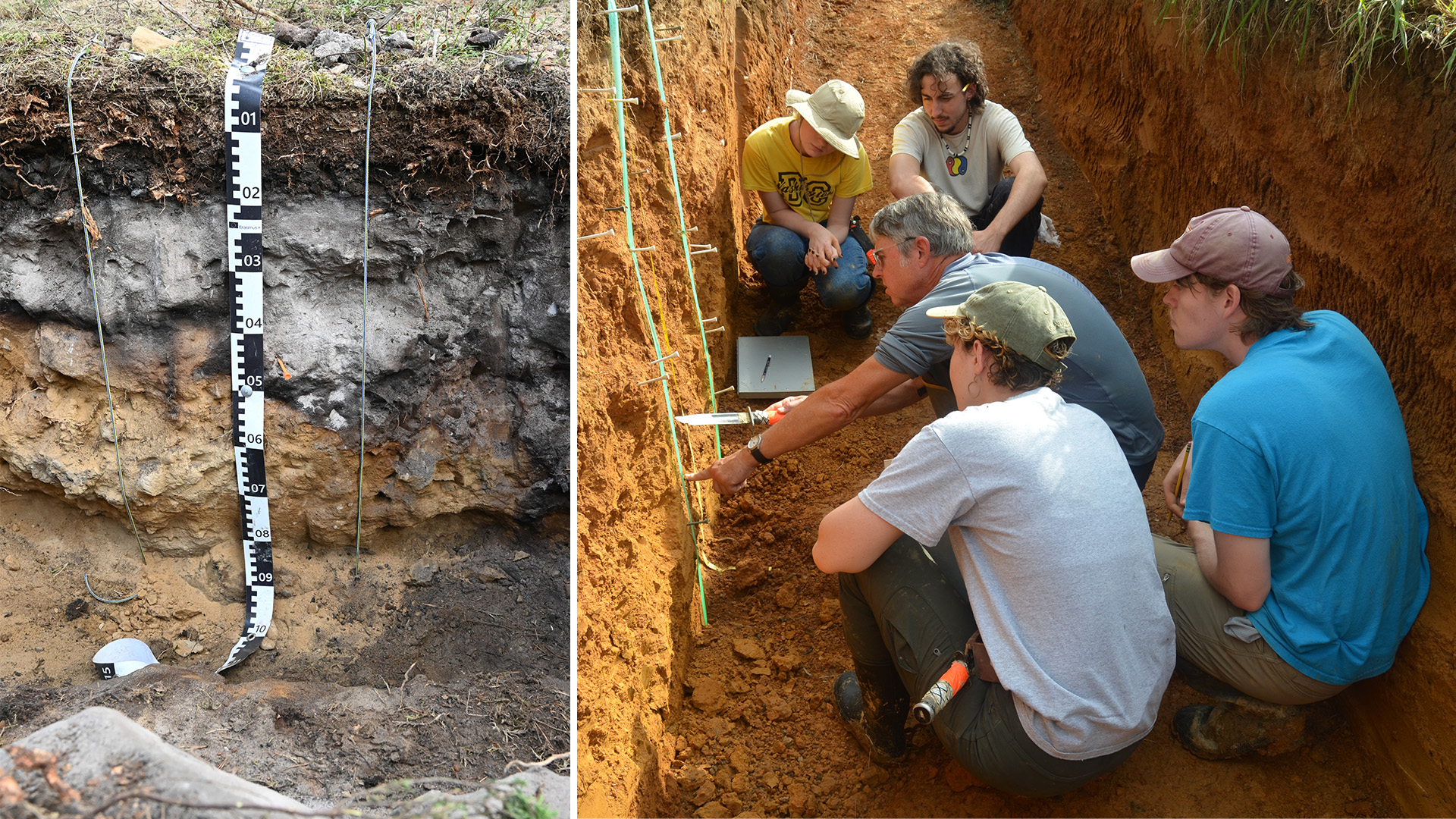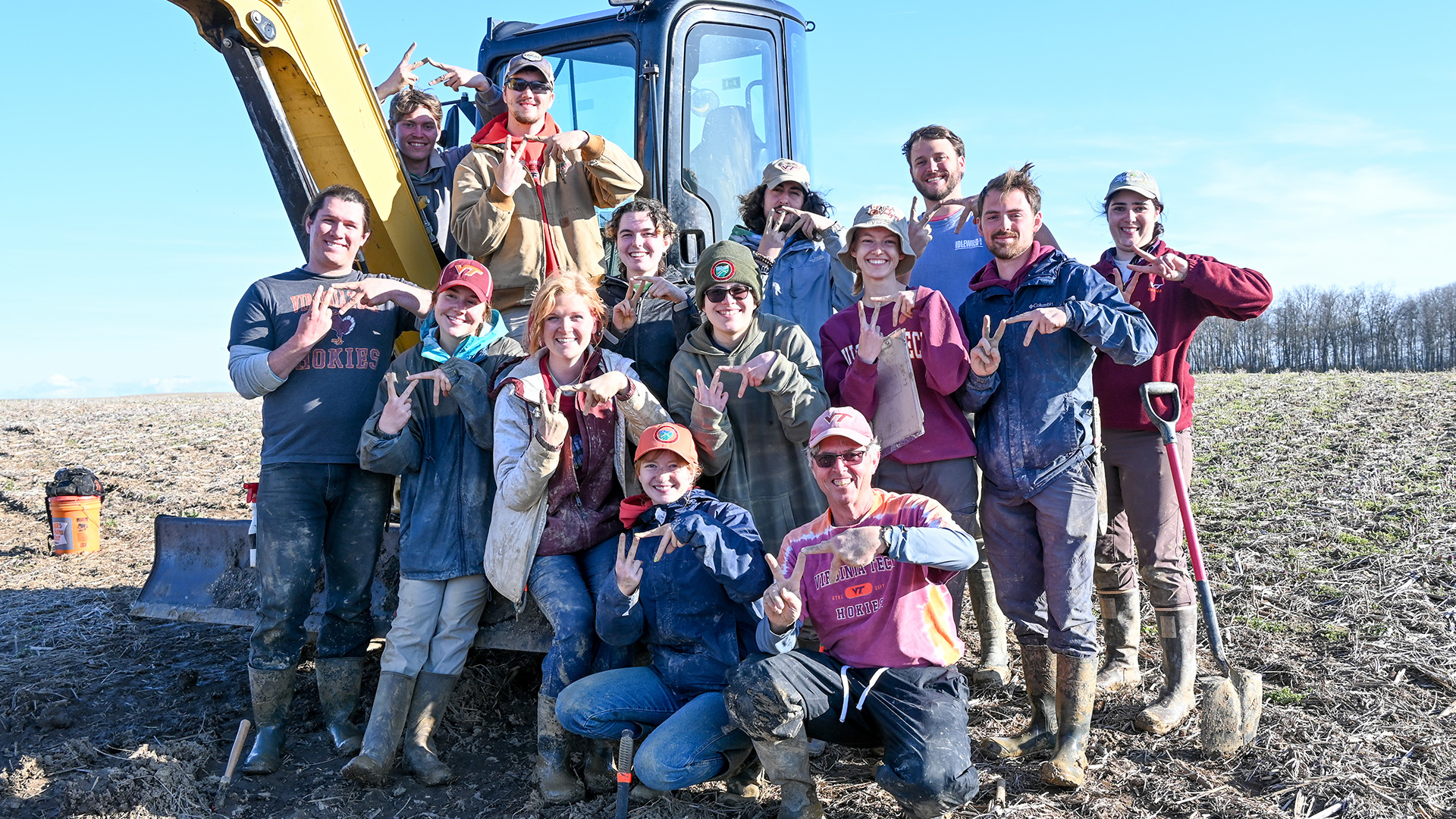Getting The Dirt On The World Of Competitive Soil Judging
8:57 minutes

If you’re looking for a new sport or hobby to try, forget about rock climbing or kitesurfing. If you don’t mind getting a bit dirty, consider competitive soil judging—a contest in which contestants work to best analyze, identify, and describe the layers of soil in a 5-foot-deep trench dug into a field. People can compete either individually, or in a team format, where different members of the team work to describe the soil’s characteristics—from color, to grain size, to how it interacts with water.
Clare Tallamy, a senior at Virginia Tech majoring in environmental science, recently won the individual competition in an international soil judging contest held in Scotland as part of the 2022 World Congress of Soil Science. She joins Ira to describe how soil judging works, gives an introduction to soil taxonomy, and explains the practical significance of being able to excel at judging a sample of soil.



Invest in quality science journalism by making a donation to Science Friday.
Clare Tallamy is the individual winner of the International Soil Judging Contest and a senior in Environmental Science at Virginia Tech in Blacksburg, Virginia.
IRA FLATOW: For the rest of the hour, a scientific sport competitive– soil judging. Yes, I said competitive soil judging, surely not an Olympic event quite yet. It’s all about being able to correctly analyze, describe, and classify different cross-sections of soil. Clare Tallamy is a senior in environmental science at Virginia Tech, and earlier this year, she won the individual international soil judging title at a competition in Scotland. Welcome to Science Friday, and congratulations.
CLARE TALLAMY: Good to be here, Ira. Thank you.
IRA FLATOW: I got to say, I’ve never heard of competitive soil judging. Just what is that?
CLARE TALLAMY: Yeah, a lot of people really haven’t heard of it. So soil judging is like you said. We identify and classify soils based on certain physical and chemical properties that we’re identifying in a cross section or a pit that’s dug out at these contests.
IRA FLATOW: So when you say judging, it’s not, this soil is great. This soil is bad. It’s classification and analysis, right?
CLARE TALLAMY: Correct. So soils aren’t really good or bad, but they are good or bad for different things. So that’s what we’re looking for. We’re looking at properties that make the soil what it is. Soils differ across the landscape, and they might be good for crops. They might be good for building buildings. Or they might just be good for just staying as is as forest or a field or something. So we’re really looking at what the soil can be used for and how it looks and how it has developed.
IRA FLATOW: OK, so you dig a trench, which, what, four or five feet deep. Then you get into this pit so you can see cross sections. Is that what you’re looking for, the different layers of soil?
CLARE TALLAMY: Yeah, so the pits are four to five feet deep. Some of them come up to my head. I am pretty tall. But it’s really fun to get in there and look at how the soil differs with depth. So we’re delineating the layers, or we call them soil horizons. And their differences are based on soil structure, soil color, and soil texture, and also we’re looking for maybe rock fragments or geologic horizons.
IRA FLATOW: So if you’re looking at layers of soils, does each type of soil have like a name? What’s an example of a common soil name? How does that work?
CLARE TALLAMY: Yes, soils do have names. Our classification system in the United States is called soil taxonomy, and so we’re classifying down to, I believe, the great group. So think of it like if you’re classifying a lion or something, we have a kingdom, phylum, class, order, genus species, so we’re classifying down to essentially the genus of the soil. So an example would be– one that we get a lot here in Virginia would be like a hapludult. So it sounds like a made-up word, but I swear it’s not.
And so it’s broken down. Yeah, it’s broken down into three parts. So there’s haplu, which is the first part of the word. It means simple, so it’s a pretty generic version of this type of soil. And then ud stands for udic, or the soil moisture regime. And there are different soil moisture regimes across the US, but in Virginia, it’s udic. And then the end of the word is ult, which stands for ultisols, and those are highly leached soils. Think those really rich red Piedmont soils that we get in the Southeast. So the whole word would be a hapludult, and that’s an example of a soil taxonomic class.
IRA FLATOW: So when you soil scientists get together, do you have a conversation with all these funny words in them?
CLARE TALLAMY: Oh, yeah. It took me a really long time to learn all the jargon, and even now, I’m learning things. I think when my parents hear me talk about soil, they really have no idea what I’m talking about. But yeah.
IRA FLATOW: Now, what is the practical application of knowing all of this stuff and even competing in soil judging?
CLARE TALLAMY: So there’s a lot of benefits to competing in soil judging. Not only does it look good on my resume as a college student, but it gets you practical field skills to get jobs, especially for government work. Really, soil judging is skills used for soil mapping and soil description. Soil maps are used for farmers or civil engineers or city planners.
They’re using soils to actually create a human environment or create agricultural systems. You can also go into academia and do a lot of research. That’s personally what I want to do. Or if you just want to be outside and know more about the environment around you– I know my parents rely on my skills for their garden a lot, looking at soil fertility or using soil mapping or looking at soil maps and saying, oh, like I said before, this is a hapludult. Then I can look at the natural fertility of the existing soil and use that to create a better soil.
IRA FLATOW: This is Science Friday from WNYC Studios. And how does soil judging become a team sport? It sounds like it’s just one person there in the pit, working on the layers.
CLARE TALLAMY: Soil judging is a group contest as well, and it’s actually my favorite part because you get to work with your teammates to create a cohesive description and learn from each other and work together as a machine to describe the soil. So for Virginia Tech, we have different teams that kind of work on different parts of the soil description. So I was personally on the pit description team, so I would be describing the layers. And I’d be doing the taxonomy portion, so identifying the soil. But then we had other teams, working on doing soil textures, soil color, doing calculations, looking for structure, wetness features.
IRA FLATOW: Is this all in the same pit, all together, looking at the same soil?
CLARE TALLAMY: Yeah, so it’s actually kind of hard to fit 13 people in one soil pit, but we make it work.
IRA FLATOW: Wow, wow. I have a question. I have to ask you this, every time we have a soil scientist on. And that question is, what’s the difference between dirt and soil?
CLARE TALLAMY: That’s a really good question. I think it’s a heavily, maybe, debated question, but I did just read an opinion piece about taking, I guess, the pretentiousness out of soil science and kind of reintroducing the word dirt back into it. But if you want the real, I guess, difference–
IRA FLATOW: Yeah, yeah, give me the real thing.
CLARE TALLAMY: So soil has a very long definition, and my professor can argue about it all the time. But soil is an in situ kind of blanket that covers the Earth. It has to be connected to the outer environment and be affected by soil-forming factors like climate, water tables, organisms, all those things that make soil different across the landscape. And then it also has to be in place long enough to experience pedogenic development, or kind of soil development, and so that’s not just geologic deposits creating layers. That’s actual movement of secondary particles through time, so thinking about clay moving through soil with time, humus moving through soil with time. So it has to have those soil layers not necessarily geologic layers. People can argue that it has to support plant life as well, but.
IRA FLATOW: Yeah, and dirt is just crushed rock or something?
CLARE TALLAMY: Dirt could be anything, I feel like. Dirt could be rock. Dirt could be like schmutz on your face after being in the field. It’s kind of like soil but not in the context of the environment. So like potting soil isn’t soil. Potting soil is just in a vessel, and it’s not really connected. So that would be dirt.
IRA FLATOW: Right. Speaking of vessel, is there a soil-judging trophy you get to take home?
CLARE TALLAMY: Oh, yes, kind of. It’s kind of like the Stanley Cup, the one from the International contest. So it’s a big traveling trophy. Currently, it’s at the headquarters of the SSSA, Soil Science Society of America. I don’t have it. I really wanted to drink something out of it, but unfortunately, they wouldn’t let me. But it’s pretty big. It’s pretty cool.
IRA FLATOW: When did you first discover that you wanted to get your hands dirty with soil?
CLARE TALLAMY: I think the complicated maybe whimsical answer is, when I was a kid, who doesn’t want to play in dirt? You’re outside, and you just are so curious about the world around you. And I think I just didn’t stop being curious. I love learning about things. Soil is infinitely complex, and so it makes it really interesting to study because I don’t have to confine myself to one field. I could study soil physics, soil microbiology, soil chemistry, soil description, soil ecology. Soil is connected to everything. So when I study soil, I, essentially, study the environment, the ecosystem, and the world around me.
IRA FLATOW: Yeah, that’s a good place to end because that’s exactly how it works. We’re all connected together. Clare Tallamy, thank you for taking time to be with us today, and congratulations, once again.
CLARE TALLAMY: Thank you so much. Thank you for having me.
IRA FLATOW: Clare Tallamy is a senior in environmental science at Virginia Tech and this year’s individual international soil judging champion. And you can see some pictures of soil judging– I’ll bet you never thought you could– and some soil activities on our website, sciencefriday.com/soil.
As Science Friday’s director and senior producer, Charles Bergquist channels the chaos of a live production studio into something sounding like a radio program. Favorite topics include planetary sciences, chemistry, materials, and shiny things with blinking lights.
Ira Flatow is the founder and host of Science Friday. His green thumb has revived many an office plant at death’s door.